Luck keeps Deer Park man alive during WWII

Three Japanese snipers who got into a shoot out with U.S. troops and lost during the Battle of Leyte Gulf. Courtesy of Wikimedia Commons.
The Battle of Leyte Gulf is considered by many to be largest naval battle during World War II, so it is often forgotten that troops were sent ashore to capture Leyte Island once the gulf was won.
The United States’ victory in October 1944 secured the seas around the islands in the Leyte Gulf, but the Japanese still held the islands. On December 7, the 77th Infantry Division, under the command of Major General Andrew Bruce, made an amphibious landing at Albuera, a city on Leyte Island. The 305th, 306th, and 307th Infantry Regiments came ashore without incident, but that peace wouldn’t last.
Kamikaze attacks sunk U.S. destroyers. Japanese troops on the island regrouped and began fighting back against the Americans. Private Denver C. Sharpless of Deer Park, Md., was among the U.S. troops taking fire.
He had been overseas for a year after having gone through basic training at Fort Jackson in South Carolina. He had enlisted in the army at Fort Meade in April 1942 for the “duration of the War or other emergency, plus six months,” which was a standard enlistment for WWII.
The 30-year-old infantryman had just taken cover in a ditch during a firefight when he saw a Japanese soldier emerge from his cover.
“He was the biggest Jap I ever saw,” Sharpless told an interviewer while he was in the hospital recovering from a nerve ailment in his right leg. “Must have been more than six feet and I’m not exaggerating when I say that his head was as big as one of our helmets.”
The average height of Japanese soldiers during the war was under five feet five inches. Sharpless himself was only five feet eight inches tall and weighed 152 pounds.
Sharpless wasn’t too scared of the Japanese solider. Sharpless had found cover and he had his rifle. And that big, hulking soldier made an easy target.
Then the Japanese soldier saw Sharpless and dropped out of sight. The Japanese soldier began crawling and Sharpless saw him again when he passed through an open area 25 yards away.
“Then I began to get frightened because, when I pulled the trigger, my M1 wouldn’t fire,” Sharpless said. “I yanked open the bolt and saw that the firing pin was broken.”
Sharpless was considering scurrying away so he didn’t fall within the soldier’s sights. Then Sharpless saw another American with a Browning Automatic Rifle coming toward him. The American soldier had also seen the Japanese soldier.
Sharpless asked to borrow the man’s rifle, but the soldier told him that he wanted to take out the Japanese soldier. He fired a couple shots and the Japanese soldier went down.
“I wished at the time that I had a camera to take his picture,” Sharpless said. “He looked like one of those oversize freaks you see in comic strips.”
Besides fighting at Leyte, Sharpless also fought on Guam. He earned the Combat Infantry Badge for exemplary conduct under fire and the Philippines Liberation campaign ribbon. Despite surviving enemy fire, the nerve ailment manifested itself a few months later. It severity required that he be sent to a California hospital for treatment.
He was the son of Robert and Bertha Sharpless. His parents had divorced at a young age, though, and he had been raised by his mother in Deer Park. His father was a coal miner who lived in Swanton and had remarried.
Denver died in Ohio in 1991.





